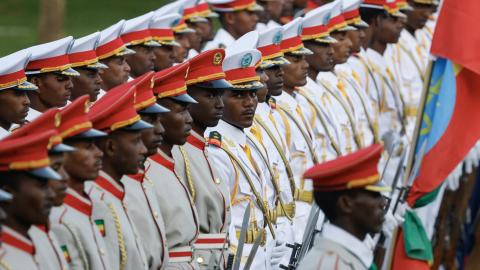The Taliban’s de facto minister of refugees and repatriation, Khalil Ur-Rahman Haqqani, was killed along with five others in a bomb explosion in Kabul last week. This marked the first time since the Taliban retook Afghanistan in 2021 that a senior member of the group had been assassinated.
Haqqani’s assassination is significant not only because of his role in the Taliban, but also due to his family connections. He was the uncle of Sirajuddin Haqqani, the current de facto interior minister and senior leader of the Haqqani Network. During the early days after the Taliban recaptured Kabul in August 2021, Khalil Haqqani was responsible for the city’s security, making him a difficult target. His nephew oversees Afghanistan’s internal security, adding another layer of complexity to targeting the Haqqani family in Kabul.
While Daesh immediately claimed responsibility for the attack, the situation may not be so straightforward. In the past, Daesh has been known to claim responsibility for attacks it had no part in to boost its image. A more plausible explanation is that this was an inside job, reflecting the fractured nature of the Taliban.
From the outside, the Taliban might appear monolithic, but today’s group is not the same one that first took power during Afghanistan's civil war in the 1990s. After being ousted by international forces in 2001, the Taliban splintered over the next 20 years into competing factions. Now, there is a patchwork of groups vying for influence. The two prominent wings are the Haqqani faction, led by Sirajuddin Haqqani, and the Kandahari faction, led by Hibatullah Akhundzada. However, other factions also play significant roles, including the Baradar and Yaqoob wings of the Kandahari faction and non-Pashtun Taliban groups operating in northern Afghanistan.
The most likely faction behind Khalil Haqqani’s assassination is the Kandahari faction. Tensions between Sirajuddin Haqqani and Akhundzada have been mounting, with both vying for greater influence. Sirajuddin Haqqani recently criticized Akhundzada during a madrasa graduation ceremony in Paghman, near Kabul. This public slight is thought to have triggered the assassination of Sirajuddin’s uncle. Such acts underscore the fragile and increasingly volatile dynamics within the Taliban’s leadership structure.
These internal divisions make forming an effective Taliban government almost impossible. The assassination of a senior leader by another faction exacerbates an already precarious situation in Afghanistan. Each faction seeks to consolidate power, further destabilizing the country.
Beyond Taliban infighting, millions of Afghans struggle daily to survive. According to a report by the UN Office for the Coordination of Humanitarian Affairs, “more than half of Afghanistan’s population will require humanitarian assistance” this year. The report describes a dire situation, with widespread displacement, landmine contamination, restricted movement, gender-based violence, child labor, early marriage and increasing mental health needs.
Minority ethnic groups such as Uzbeks, Tajiks and Hazaras face severe persecution and women’s rights have eroded to near nonexistence. Aside from limited roles in education and healthcare, women are effectively barred from the workforce and girls are denied education beyond the sixth grade. Under such conditions, the future of millions of Afghans is bleak.
While girls are being deprived of education, young boys are being radicalized in Taliban-run schools. Recently, a Taliban official from the Ministry of Education announced a new exam titled “Ideological War Against the West,” to be administered in schools and madrasas. This reflects the Taliban’s broader effort to indoctrinate a new generation of extremists, particularly against Western countries. Such actions not only rob Afghan children of a future, but they also lay the groundwork for continued cycles of violence and extremism.
Meanwhile, the Taliban have done little to stem the growth of terrorist organizations in Afghanistan since their return to power in 2021. Groups such as Al-Qaeda and Daesh have only grown stronger amid the chaos. Daesh, in particular, has expanded its recruitment and conducted high-profile attacks, often targeting the Hazara community. A UN report this summer estimated that Daesh had between 4,000 and 6,000 fighters, despite leadership losses. The group has exploited the Taliban’s internal divisions and lack of governance, positioning itself as an alternative power center in Afghanistan.
Al-Qaeda has similarly benefited from the Taliban’s return. The group maintains a close relationship with the Taliban, with cells operating across multiple provinces, primarily in the southeast. Al-Qaeda has also established new training camps, attracting fighters from across the region. In 2022, a US drone strike in Kabul killed Al-Qaeda leader Ayman Al-Zawahiri, underscoring the group’s reemergence in Afghanistan. The Taliban’s inability or unwillingness to rein in such groups raises significant concerns for regional and global security.
Despite these alarming developments, the international community remains largely indifferent. Millions of Afghans continue to suffer through a humanitarian crisis and terrorist organizations flourish unchecked. The lack of international engagement leaves Afghanistan’s future in the hands of factions more focused on power struggles than governance.
Khalil Haqqani’s assassination could further escalate tensions between the Haqqani and Kandahari factions, potentially leading to open conflict or even an internal civil war if retaliation occurs. Such a scenario would provide groups like Al-Qaeda and Daesh with an opportunity to exploit the ensuing chaos and strengthen their foothold in Afghanistan. Meanwhile, ordinary Afghans will continue to bear the brunt of violence, poverty and international neglect.
As 2024 comes to a close, the outlook for Afghanistan remains grim. Unless the international community takes meaningful action, the country’s downward spiral will only accelerate, with devastating consequences for its people and global security.
Enjoyed this article? Subscribe to Hudson’s newsletters to stay up to date with our latest content.



















